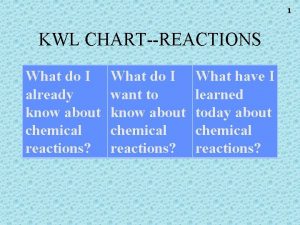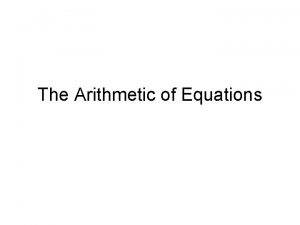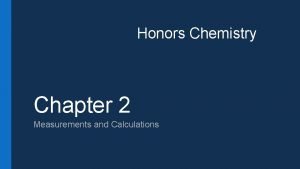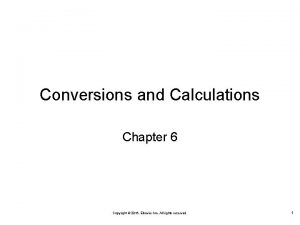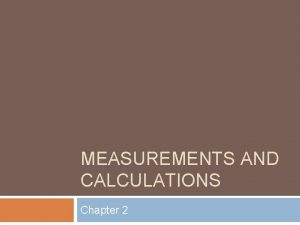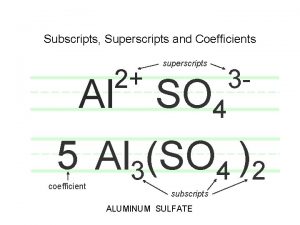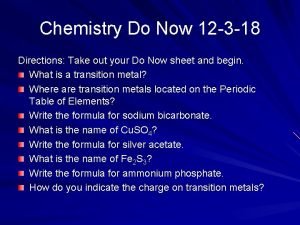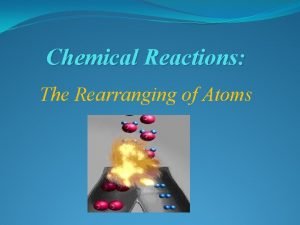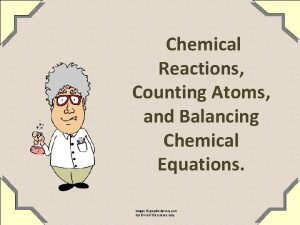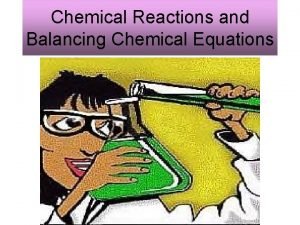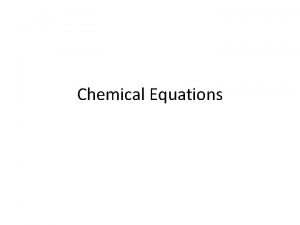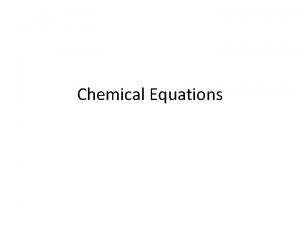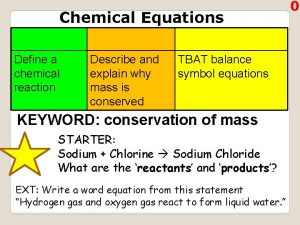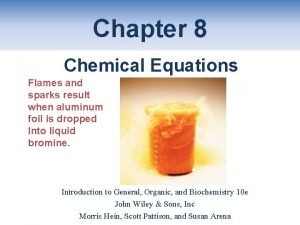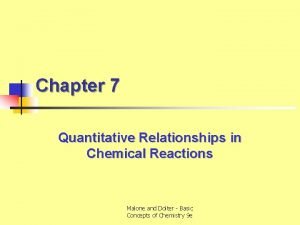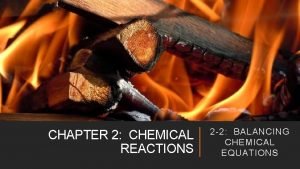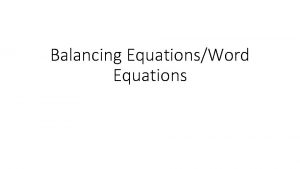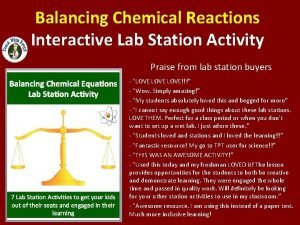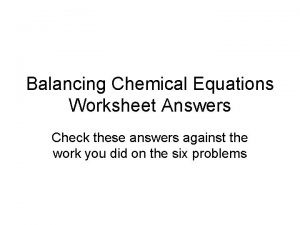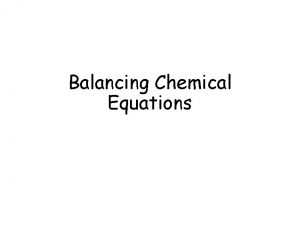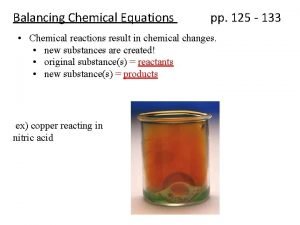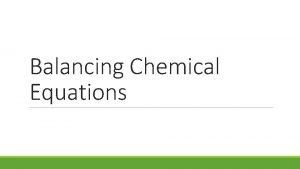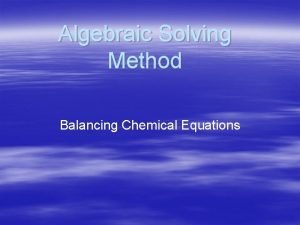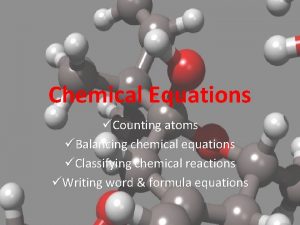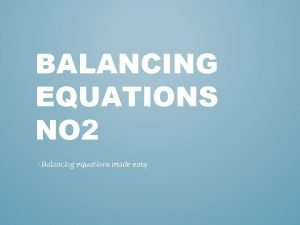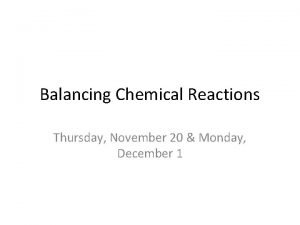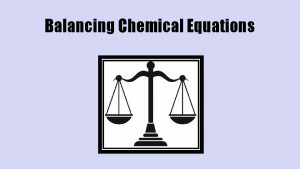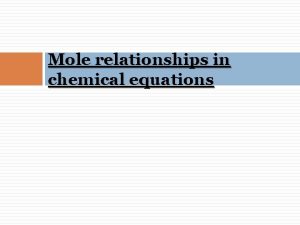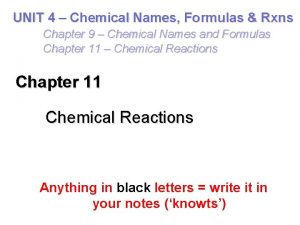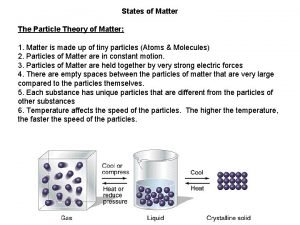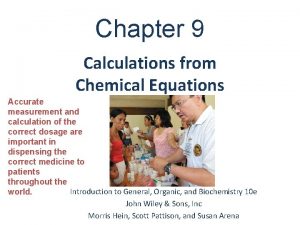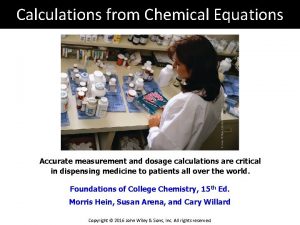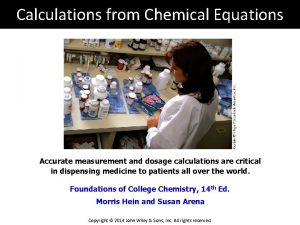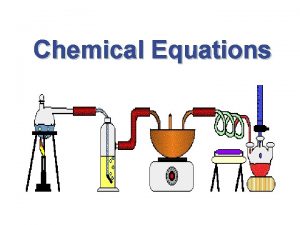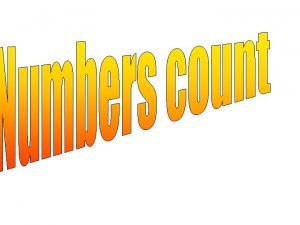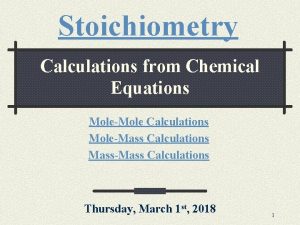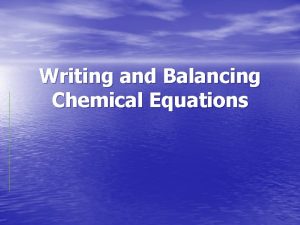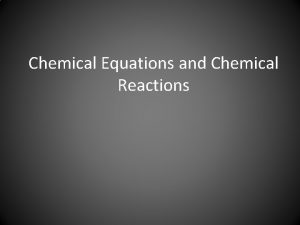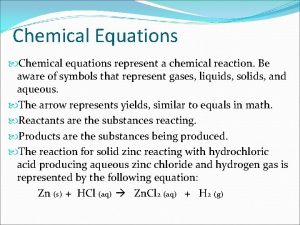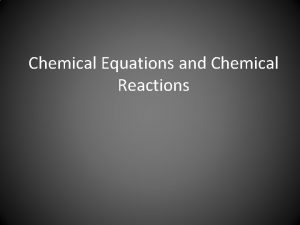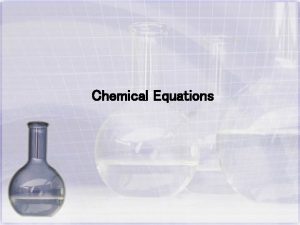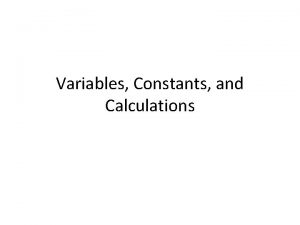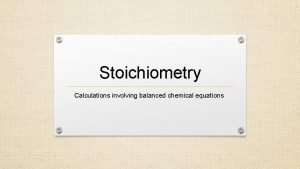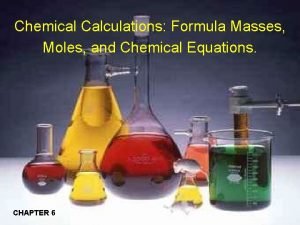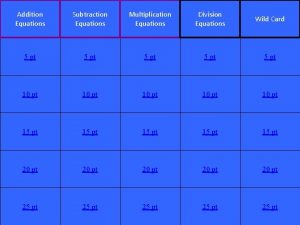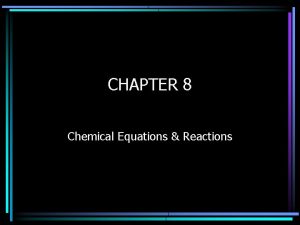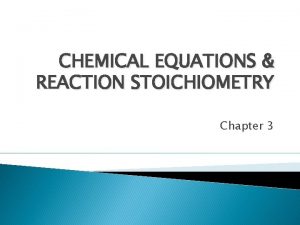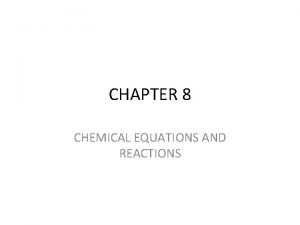Chapter 9 Calculations from Chemical Equations Accurate measurement

















































- Slides: 49

Chapter 9 Calculations from Chemical Equations Accurate measurement and calculation of the correct dosage are important in dispensing the correct medicine to patients Introduction to General, Organic, and Biochemistry 10 e throughout the John Wiley & Sons, Inc world. Morris Hein, Scott Pattison, and Susan Arena

Chapter Outline 9. 1 A Short Review 9. 5 Mass-Mass Calculations 9. 2 Introduction to Stoichiometry 9. 6 Limiting Reactant and Yield Calculations 9. 3 Mole-Mole Calculations 9. 4 Mole-Mass Calculations Copyright 2012 John Wiley & Sons, Inc 9 -2

Molar Mass – sum of atomic masses of all atoms in 1 mole of an element or compound ; the units are g/mol. 1 mole = 6. 022 x 1023 molecules 6. 022 x 1023 formula units 6. 022 x 1023 atoms 6. 022 x 1023 ions Copyright 2012 John Wiley & Sons, Inc 9 -3

Molar Mass What is the molar mass of Al(Cl. O 3)3? Al 1(26. 98 g) 3 Cl 3(35. 45 g) 9 O 9(16. 00 g) Al(Cl. O 3)3 277. 33 g/mol Copyright 2012 John Wiley & Sons, Inc atomic mass Al 26. 98 Cl 35. 45 O 16. 00 7 -4

Molar Mass Calculate the mass of 2. 5 moles of aluminum chlorate. Plan 2. 5 mol Al(Cl. O 3)3 g Al(Cl. O 3)3 1 mol Al(Cl. O 3)3 = 277. 33 g Al(Cl. O 3)3 Calculate Copyright 2012 John Wiley & Sons, Inc 9 -5

Molar Mass Calculate the moles of 3. 52 g of aluminum chlorate. Plan 3. 52 g Al(Cl. O 3)3 mol Al(Cl. O 3)3 1 mol Al(Cl. O 3)3 = 277. 33 g Al(Cl. O 3)3 Calculate Copyright 2012 John Wiley & Sons, Inc 9 -6

Molar Mass Calculate the number of formula units contained in 12. 4 g aluminum chlorate. 12. 4 g Al(Cl. O 3)3 formula units Al(Cl. O 3)3 Plan 1 mol Al(Cl. O 3)3 = 277. 33 g = 6. 022 x 1023 formula units Calculate Copyright 2012 John Wiley & Sons, Inc 9 -7

Your Turn! What is the mass of 3. 61 moles of Ca. Cl 2? a. 3. 61 g Ca b. 272 g Cl 24 c. 2. 17 × 10 g d. 401 g Copyright 2012 John Wiley & Sons, Inc atomic mass 40. 08 35. 45 9 -8

You Turn! How many moles of HCl are contained in 18. 2 g HCl? atomic mass a. 1. 00 mol H 1. 01 b. 0. 500 mol Cl 35. 45 c. 0. 250 mol d. 0. 125 mol Copyright 2012 John Wiley & Sons, Inc 9 -9

Your Turn! What is the mass of 1. 60× 1023 molecules of HCl? atomic mass a. 9. 69 g H 1. 01 b. 137 g Cl 35. 45 c. 0. 729 g d. 36. 5 g Copyright 2012 John Wiley & Sons, Inc 9 -10

Stoichiometry deals with the quantitative relationships between the reactants and products in a balanced chemical equation. 1 N 2(g) + 3 I 2(s) 2 NI 3(s) 1 mol N 2 + 3 mol I 2 2 mol NI 3 Mole ratios come from the coefficients in the balanced equation: The 3 other possibilities are the inverse of these ratios. Copyright 2012 John Wiley & Sons, Inc 9 -11

Your Turn! Which of these statements is not true about the reaction? 1 N 2(g) + 3 I 2(s) 2 NI 3(s) a. 1 mole of nitrogen is needed for every 3 moles of iodine b. 1 gram of nitrogen is needed for every 3 grams of iodine c. Both statements are true Copyright 2012 John Wiley & Sons, Inc 9 -12

Using the mole ratio Calculate the number of moles of NI 3 that can be made from 5. 50 mol N 2 in the reaction: 1 N 2(g) + 3 I 2(s) 2 NI 3(s) Plan 5. 50 mol N 2 mol NI 3 Set-Up Calculate Copyright 2012 John Wiley & Sons, Inc 9 -13

Using the mole ratio Calculate the number of moles of I 2 needed to react with 5. 50 mol N 2 in the reaction: 1 N 2(g) + 3 I 2(s) 2 NI 3(s) Plan 5. 50 mol N 2 mol I 2 Set-Up Calculate Copyright 2012 John Wiley & Sons, Inc 9 -14

Your Turn! How many moles of HF will be produced by the complete reaction of 1. 42 moles of H 2 in the following equation? H 2 + F 2 2 HF a. 0. 710 b. 1. 42 c. 2. 00 d. 2. 84 Copyright 2012 John Wiley & Sons, Inc 9 -15

Stoichiometry Problem Solving Strategy for stoichiometry problems: 1. Convert starting substance to moles. 2. Convert the moles of starting substance to moles of desired substance. 3. Convert the moles of desired substance to the units specified in the problem. Copyright 2012 John Wiley & Sons, Inc 9 -16

Stoichiometry Copyright 2012 John Wiley & Sons, Inc 9 -17

Mole-Mole Calculations How many moles of Al are needed to make 0. 0935 mol of H 2? 2 Al(s) + 6 HCl (aq) 2 Al. Cl 3(aq) + 3 H 2(g) Plan 0. 0935 mol H 2 mol Al Set-Up Calculate Copyright 2012 John Wiley & Sons, Inc 9 -18

Mole-Mole Calculations How many moles of HCl are needed to make 0. 0935 mol of H 2? 2 Al(s) + 6 HCl (aq) 2 Al. Cl 3(aq) + 3 H 2(g) Plan 0. 0935 mol H 2 mol HCl Set-Up Calculate Copyright 2012 John Wiley & Sons, Inc 9 -19

Your Turn! How many moles of H 2 are made by the reaction of 1. 5 mol HCl with excess aluminum? 2 Al(s) + 6 HCl (aq) 2 Al. Cl 3(aq) + 3 H 2(g) a. 0. 75 mol b. 3. 0 mol c. 6. 0 mol d. 4. 5 mol Copyright 2012 John Wiley & Sons, Inc 9 -20

Your Turn! How many moles of carbon dioxide are produced when 3. 00 moles of oxygen react completely in the following equation? C 3 H 8 + 5 O 2 3 CO 2 + 9 H 2 O a. 5. 00 mol b. 3. 00 mol c. 1. 80 mol d. 1. 50 mol Copyright 2012 John Wiley & Sons, Inc 9 -21

Your Turn! How many moles of C 3 H 8 are consumed when 1. 81 x 1023 molecules of CO 2 are produced in the following equation? C 3 H 8 + 5 O 2 3 CO 2 + 4 H 2 O a. 0. 100 b. 0. 897 c. 6. 03 × 1022 d. 5. 43 × 1023 Copyright 2012 John Wiley & Sons, Inc 9 -22

Mole-Mass Calculations What mass of H 2 (2. 02 g/mol) is made by the reaction of 3. 0 mol HCl with excess aluminum? 2 Al(s) + 6 HCl (aq) 2 Al. Cl 3(aq) + 3 H 2(g) Plan 3. 0 mol HCl mol H 2 g H 2 Calculate Copyright 2012 John Wiley & Sons, Inc 9 -23

Mole-Mass Calculations How many moles of HCl are needed to completely consume 2. 00 g Al (26. 98 g/mol)? 2 Al(s) + 6 HCl (aq) 2 Al. Cl 3(aq) + 3 H 2(g) Plan 2. 00 g Al mol HCl Calculate Copyright 2012 John Wiley & Sons, Inc 9 -24

Mole-Mass Calculations What mass of Al(NO 3)3 (213 g/mol) is needed to react with. 093 mol Na 2 CO 3? 3 Na 2 CO 3(aq) + 2 Al(NO 3)3(aq) Al 2(CO 3)3(s) + 6 Na. NO 3(aq) Plan 0. 093 mol Na 2 CO 3 mol Al(NO 3)3 g Al(NO 3)3 Calculate Copyright 2012 John Wiley & Sons, Inc 9 -25

Mole-Mass Calculations How many moles of Al 2(CO 3)3 are made by the reaction of 3. 45 g Na 2 CO 3 (105. 99 g/mol) with excess Al(NO 3)3? 3 Na 2 CO 3(aq) + 2 Al(NO 3)3(aq) Al 2(CO 3)3(s) + 6 Na. NO 3(aq) Plan 3. 45 g Na 2 CO 3 mol Na 2 CO 3 g Al 2(CO 3)3 Calculate Copyright 2012 John Wiley & Sons, Inc 9 -26

Your Turn! How many moles of oxygen are consumed when 38. 0 g of aluminum oxide are produced in the following equation? atomic mass 4 Al(s) + 3 O 2(g) 2 Al 2 O 3(s) Al 26. 98 a. 0. 248 O 16. 00 b. 0. 559 c. 1. 50 d. 3. 00 Copyright 2012 John Wiley & Sons, Inc 9 -27

Your Turn! What mass of HCl is produced when 1. 81 x 1024 molecules of H 2 react completely in the following equation? atomic mass H 2(g) + Cl 2(g) 2 HCl(g) H 1. 01 a. 54. 7 g Cl 35. 45 b. 72. 9 g c. 109 g d. 219 g Copyright 2012 John Wiley & Sons, Inc 9 -28

Mass-Mass Calculations Now we will put it all together. What mass of Br 2 (159. 80 g/mol) is needed to completely consume 7. 00 g Al (26. 98 g/mol)? 2 Al(s) + 3 Br 2(l) 2 Al. Br 3(s) 7. 00 g Al mol Al mol Br 2 g Br 2 Copyright 2012 John Wiley & Sons, Inc 9 -29

Mass-Mass Calculations What mass of Br 2 (159. 80 g/mol) is needed to completely consume 7. 00 g Al (26. 98 g/mol)? 2 Al(s) + 3 Br 2(l) 2 Al. Br 3(s) Plan 7. 00 g Al mol Al mol Br 2 g Br 2 Calculate Copyright 2012 John Wiley & Sons, Inc 9 -30

Mass-Mass Calculations What mass of Fe 2 S 3 (207. 91 g/mol) can be made from the reaction of 9. 34 g Fe. Cl 3 (162. 20 g/mol) with excess Na 2 S? 2 Fe. Cl 3(aq) + 3 Na 2 S(aq) Fe 2 S 3(s) + 6 Na. Cl(aq) Plan 9. 34 g Fe. Cl 3 mol Fe 2 S 3 g Fe 2 S 3 Calculate Copyright 2012 John Wiley & Sons, Inc 9 -31

Your Turn! What mass of oxygen is consumed when 54. 0 g of water is produced in the following equation? 2 H 2 + O 2 2 H 2 O atomic mass H 1. 01 a. 0. 167 g O 16. 00 b. 0. 667 g c. 1. 50 g d. 47. 9 g Copyright 2012 John Wiley & Sons, Inc 9 -32

Your Turn! What mass of H 2 O is produced when 12. 0 g of HCl react completely in the following equation? 6 HCl + Fe 2 O 3 2 Fe. Cl 3 + 3 H 2 O a. 2. 97 g atomic mass b. 39. 4 g H 1. 01 O 16. 00 c. 27. 4 g Cl 35. 45 d. 110. g Copyright 2012 John Wiley & Sons, Inc 9 -33

Limiting Reactant Determine the number of that can be made given these quantities of reactants and the reaction equation: + + Copyright 2012 John Wiley & Sons, Inc 9 -34

Limiting Reactant The limiting reactant is the reactant that limits the amount of product that can be made. The reaction stops when the limiting reactant is used up. What was the limiting reactant in the reaction: + The small blue balls. Copyright 2012 John Wiley & Sons, Inc 9 -35

Excess Reactant The excess reactant is the reactant that remains when the reaction stops. There is always left over excess reactant. What was the excess reactant in the reaction: + The excess reactant was the larger blue ball. Copyright 2012 John Wiley & Sons, Inc 9 -36

Limiting reactant Figure 9. 2 The number of bicycles that can be built from these parts is determined by the “limiting reactant” (the pedal assemblies). Copyright 2012 John Wiley & Sons, Inc 9 -37

Limiting Reactant Calculations Technique for solving limiting reactant problems: 1. Convert reactant 1 to moles or mass of product 2. Convert reactant 2 to moles or mass of product 3. Compare answers. The smaller answer is the maximum theoretical yield. Copyright 2012 John Wiley & Sons, Inc 9 -38

Limiting Reactant Calculation Calculate the number of moles of water that can be made by the reaction of 1. 51 mol H 2 with 0. 932 mol O 2. 2 H 2(g) + O 2(g) 2 H 2 O(g) 1. Calculate theoretical yield of H 2 O assuming H 2 is the limiting reactant and that O 2 is the excess reactant. 2. Calculate theoretical yield of H 2 O assuming that O 2 is the limiting reactant and that H 2 is the excess reactant. Copyright 2012 John Wiley & Sons, Inc 9 -39

Limiting Reactant Calculation continued Assuming that H 2 is limiting and O 2 is excess: Assuming that O 2 is limiting and H 2 is excess: So what is the maximum yield of H 2 O? Copyright 2012 John Wiley & Sons, Inc 9 -40

Limiting Reactant Calculation continued How much H 2 and O 2 remain when the reaction stops? H 2: Limiting Reactant – None remains. It was used up in the reaction. O 2: Excess Reactant – Calculate the amount of O 2 used in the reaction with H 2. Then subtract that from the original amount. Copyright 2012 John Wiley & Sons, Inc 9 -41

Limiting Reactant Calculation Calculate the mass of copper that can be made from the combination of 15. 0 g aluminum with 25. 0 g copper(II) sulfate. 2 Al(s) + 3 Cu. SO 4(aq) Al 2(SO 4)3(aq) + 3 Cu(s) Plan 15 g Al mol Cu g Cu 25 g Cu. SO 4 mol Cu g Cu Compare answers. The smaller number is the right answer. Copyright 2012 John Wiley & Sons, Inc 9 -42

Limiting Reactant Calculation continued 2 Al(s) + 3 Cu. SO 4(aq) Al 2(SO 4)3(aq) + 3 Cu(s) 1. Assume Al is limiting and Cu. SO 4 is in excess. 53. 0 g Cu 2. Assume Cu. SO 4 is limiting and Al is in excess. 9. 96 g Cu 3. Compare answers. Cu. SO 4 is the limiting reagent. The theoretical yield of Cu is 9. 96 g. Copyright 2012 John Wiley & Sons, Inc 9 -43

Your Turn! True/False: You can compare the quantities of reactant when you work a limiting reactant problem. The reactant you have the least of is the limiting reactant. a. True b. False Copyright 2012 John Wiley & Sons, Inc 9 -44

Your Turn! Which is the limiting reactant when 3. 00 moles of copper are reacted with 3. 00 moles of silver nitrate in the following equation? Cu + 2 Ag. NO 3 Cu(NO 3)2 + 2 Ag a. Cu b. Ag. NO 3 c. Cu(NO 3)2 d. Ag Copyright 2012 John Wiley & Sons, Inc 9 -45

Your Turn! What is the mass of silver (107. 87 g/mol) produced by the reaction of 3. 00 moles of copper with 3. 00 moles of silver nitrate? Cu + 2 Ag. NO 3 Cu(NO 3)2 + 2 Ag a. 162 g b. 216 g c. 324 g d. 647 g Copyright 2012 John Wiley & Sons, Inc 9 -46

Percent Yield To determine the efficiency of a process for making a compound, chemists compute the percent yield of the reaction. The theoretical yield is the result calculated using stoichiometry. The actual yield of a chemical reaction is the experimental result, which is often less than theoretical yield due to experimental losses and errors along the way. Copyright 2012 John Wiley & Sons, Inc 9 -47

Percent Yield Calculate the % yield of PCl 3 that results from reacting 5. 00 g P with excess Cl 2 if only 17. 2 g of PCl 3 were recovered. 2 P + 3 Cl 2 2 PCl 3 Compute the expected yield of PCl 3 from 5. 00 g P with excess Cl 2. 2 g PCl 3 Compute the % Yield. Copyright 2012 John Wiley & Sons, Inc 9 -48

Your Turn! In a reaction to produce ammonia, theoretical yield is 420. g. What is the percent yield if the actual yield is 350. g? A. 83. 3% B. 20. 0% C. 16. 7% D. 120. % Copyright 2012 John Wiley & Sons, Inc 9 -49
 Chapter 18 chemical reactions balancing chemical equations
Chapter 18 chemical reactions balancing chemical equations Structural steel connection calculations calculations
Structural steel connection calculations calculations Translating chemical equations
Translating chemical equations The calculation of quantities in chemical reactions
The calculation of quantities in chemical reactions Calculations with balanced equations kwl chart
Calculations with balanced equations kwl chart The arithmetic of equations
The arithmetic of equations Chapter 7 chemical formulas and chemical compounds test
Chapter 7 chemical formulas and chemical compounds test Chemical formula of love
Chemical formula of love Chemical equations and reactions chapter 8 review
Chemical equations and reactions chapter 8 review Chapter 8 section 1 chemical equations and reactions
Chapter 8 section 1 chemical equations and reactions Balancing equations chapter 8
Balancing equations chapter 8 Chapter 19 chemical reactions simple word equations
Chapter 19 chemical reactions simple word equations Chapter 2 measurements and calculations
Chapter 2 measurements and calculations Conversions and calculations chapter 6
Conversions and calculations chapter 6 Measurements and calculations chapter 2 test
Measurements and calculations chapter 2 test Section 2 classifying chemical reactions
Section 2 classifying chemical reactions Section 2 classifying chemical reactions worksheet answers
Section 2 classifying chemical reactions worksheet answers Chemical reactions section 1 chemical changes
Chemical reactions section 1 chemical changes So
So Toxic reactions chemical equations answer key
Toxic reactions chemical equations answer key Chemical equation worksheet
Chemical equation worksheet Kahoot balancing chemical equations
Kahoot balancing chemical equations In a chemical reaction... atoms aren't rearranged
In a chemical reaction... atoms aren't rearranged How many atoms
How many atoms Balance chemical equations
Balance chemical equations Chemical equations vocabulary worksheet answers
Chemical equations vocabulary worksheet answers Chemical equations vocabulary
Chemical equations vocabulary Synthesis and combustion reaction
Synthesis and combustion reaction Chemical equations definition
Chemical equations definition 50 unbalanced chemical equations
50 unbalanced chemical equations Quantitative relationships in chemical equations
Quantitative relationships in chemical equations Balancing chemical equations step by step
Balancing chemical equations step by step Balancing act pogil
Balancing act pogil Balancing chemical equations station lab
Balancing chemical equations station lab Co2 + h2o c6h12o6 + o2
Co2 + h2o c6h12o6 + o2 Balancing chemical equations t chart
Balancing chemical equations t chart Skeleton equation
Skeleton equation How do you balance a chemical equation
How do you balance a chemical equation Balancing chemical
Balancing chemical Simplify chemical equations
Simplify chemical equations Unit 5 chemical reactions
Unit 5 chemical reactions Stoichiometry review answers
Stoichiometry review answers Unit 5 chemical equations and reactions
Unit 5 chemical equations and reactions Counting atoms
Counting atoms Balancing chemical equations made easy
Balancing chemical equations made easy 20 balanced chemical equations
20 balanced chemical equations Balancing chemical equations coloring snowman
Balancing chemical equations coloring snowman Mole relationships in chemical equations
Mole relationships in chemical equations Word equation for calcium chloride
Word equation for calcium chloride State of matter in chemical equations
State of matter in chemical equations




